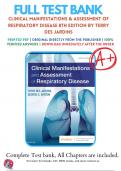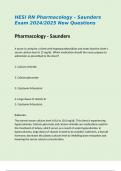PRINTED PDF | ORIGINAL DIRECTLY FROM THE PUBLISHER | 100%
VERIFIED ANSWERS | DOWNLOAD IMMEDIATELY AFTER THE ORDER
For more Test banks, ATI, HESI exams, and more contact us.
FULL TEST BANK
C l i n i c a l M a n i f e s t a t i o n s & A s s e s s m e n t o f
R e s p i r a t o r y D i s e a s e 8 t h E d i t i o n B y T e r r y
D e s J a r d i n s
Complete Test bank, All Chapters are included.
1 / 4
Table of content
Chapter 1 The Patient Interview
Chapter 2 The Physical Examination
Chapter 3 The Pathophysiologic Basis for Common Clinical Manifestations
Chapter 4 Pulmonary Function Testing
Chapter 5 Blood Gas Assessment
Chapter 6 Assessment of Oxygenation
Chapter 7 Assessment of the Cardiovascular System
Chapter 8 Radiologic Examination of the Chest
Chapter 9 Other Important Tests and Procedures
Chapter 10 The Therapist-Driven Protocol Program
Chapter 11 Respiratory Insufficiency, Respiratory Failure, and Ventilatory Management Protocols
Chapter 12 Recording Skills and Intraprofessional Communication
Chapter 13 Chronic Obstructive Pulmonary Disease, Chronic Bronchitis, and Emphysema
Chapter 14 Asthma
Chapter 15 Cystic Fibrosis
Chapter 16 Bronchiectasis
Chapter 17 Atelectasis
Chapter 18 Pneumonia, Lung Abscess Formation, and Important Fungal Diseases
Chapter 19 Tuberculosis
Chapter 20 Pulmonary Edema
Chapter 21 Pulmonary Vascular Disease
Chapter 22 Flail Chest
Chapter 23 Pneumothorax
Chapter 24 Pleural Effusion and Empyema
Chapter 25 Kyphoscoliosis
Chapter 26 Cancer of the Lung
Chapter 27 Interstitial Lung Diseases
Chapter 28 Acute Respiratory Distress Syndrome
Chapter 29 Guillain-Barré Syndrome
Chapter 30 Myasthenia Gravis
Chapter 31 Cardiopulmonary Assessment and Care of Patients with Neuromuscular Disease
Chapter 32 Sleep Apnea
Chapter 33 Newborn Assessment and Management
Chapter 34 Pediatric Assessment and Management
Chapter 35 Meconium Aspiration Syndrome
Chapter 36 Transient Tachypnea of the Newborn
Chapter 37 Respiratory Distress Syndrome
Chapter 38 Pulmonary Air Leak Syndromes
Chapter 39 Respiratory Syncytial Virus Infection (Bronchiolitis)
Chapter 40 Chronic Lung Disease of Infancy
Chapter 41 Congenital Diaphragmatic Hernia
Chapter 42 Congenital Heart Diseases
Chapter 43 Croup and Croup-Like Syndromes
Chapter 44 Near Drowning/Wet Drowning
Chapter 45 Smoke Inhalation, Thermal Lung Injuries, and Carbon Mono
2 / 4
NURSINGTB.COMChapter 01: The Patient Interview
Des Jardins: Clinical Manifestations and Assessment of Respiratory Disease, 8th
Edition
MULTIPLE CHOICE
1. The respiratory care practitioner is conducting a patient interview. The main purpose of this
interview is to:
a. review data with the patient.
b. gather subjective data from the patient.
c. gather objective data from the patient.
d. fill out the history form or checklist.
ANS: B
The interview is a meeting between the respiratory care practitioner and the patient. It
allows the collection of subjective data about the patient’s feelings reg arding his/her
condition. The history should be done before the interview. Although data can be reviewed,
that is not the primary purpose of the interview.
2. For there to be a successful interview, the respiratory therapist must:
a. provide leading questions to guide the patient.
b. reassure the patient.
c. be an active listener.
d. use medical terminology to show knowledge of the subject matter.
ANS: C
The personal qualities that a respiratory therapist must have to conduct a successful
interview include being an active listener, having a genuine concern for the patient, and
having empathy. Leading questions must be avoided. Reassurance may provide a false sense
of comfort to the patient. Medical jargon can sound exclusionary and paternalistic to a
patient.
3. Which of the following would be found on a history form?
1. Age
2. Chief complaint
3. Present health
4. Family history
5. Health insurance provid er
a. 1, 4
b. 2, 3
c. 3, 4, 5
d. 1, 2, 3, 4
ANS: D
Age, chief complaint, present health, and family history are typically found on a health
history form because each can impact the patient’s health. Health insura nce provider
information, while needed for billing purposes, would not be found on the history form.
NURSINGTB.COMClinical Manifestations and Assessment of Respiratory Disease 8th Edition Jardins Test BankWWW.NURSYLAB.COM
3 / 4
NURSINGTB.COM 4. External factors the respiratory care practitioner should make efforts to provide during an
interview include which of the following?
1. Minimize or prevent interruptions.
2. Ensure privacy during discussions.
3. Interviewer is the same sex as the patient to prevent bias.
4. Be comfortable for the patient and interviewer.
a. 1, 4
b. 2, 3
c. 1, 2, 4
d. 2, 3, 4
ANS: C
External factors, such as a good physical setting, enhance the interviewing process.
Regardless of the interview setting (the patient’s bedside, a crowded emergency room, an
office in the hospital or clinic, or the patient’s home), efforts should be made t o (1) ensure
privacy, (2) prevent interruptions, and (3) secure a comfortable physical environment (e.g.,
comfortable room temperature, sufficient lighting, absence of noise). An interviewer of
either gender, who acts professionally, should be able to interview a patient of either gender.
5. The respiratory therapist is conducting a patient interview. The therapist chooses to use
open-ended questions. Open-ended questions allow the therapist to do which of the
following?
1. Gather information when a patient introduces a new topic.
2. Introduce a new subject area.
3. Begin the interview process.
4. Gather specific information.
a. 4
b. 1, 3
c. 1, 2, 3
d. 2, 3, 4
ANS: C
An open-ended question should be used to start the interview, introduce a new section of
questions, and gather more information from a patient’s topic. Closed or direct questions are
used to gather specific information.
6. The direct question interview format is used to:
1. speed up the interview.
2. let the patient fully explain his/her situation.
3. help the respiratory therapist show empathy.
4. gather specific information.
a. 1, 4
b. 2, 3
c. 3, 4
d. 1, 2, 3
ANS: A
Direct or closed questions are best to gather specific information and speed up the interview.
Open-ended questions are best suited to let the patient fully explain his/her situation and
possibly help the respiratory therapist show empathy.
NURSINGTB.COMClinical Manifestations and Assessment of Respiratory Disease 8th Edition Jardins Test BankWWW.NURSYLAB.COMPowered by TCPDF (www.tcpdf.org)
4 / 4





